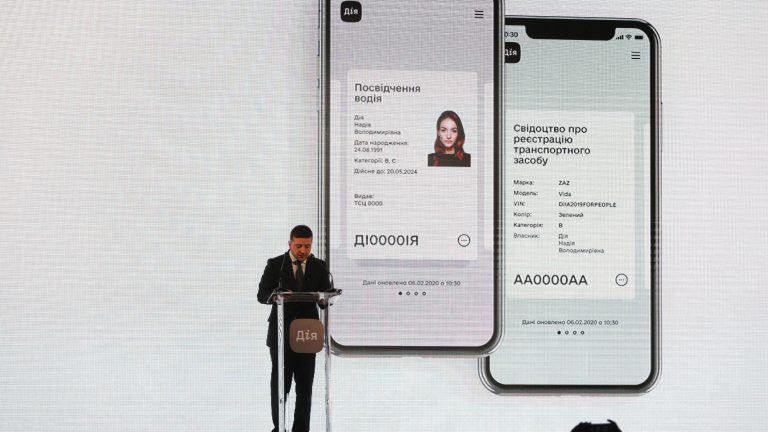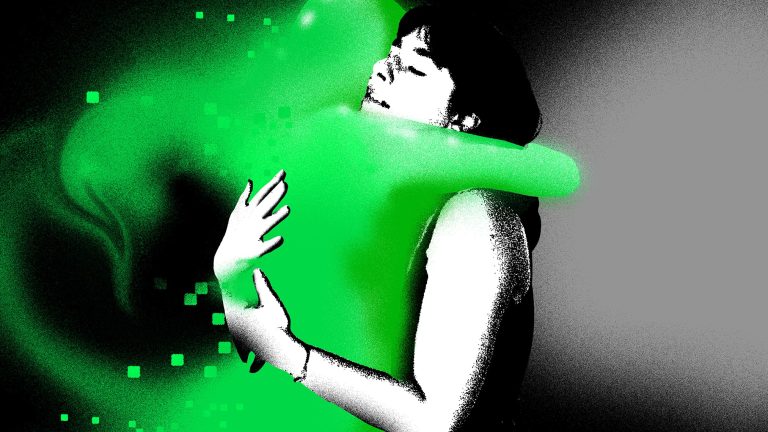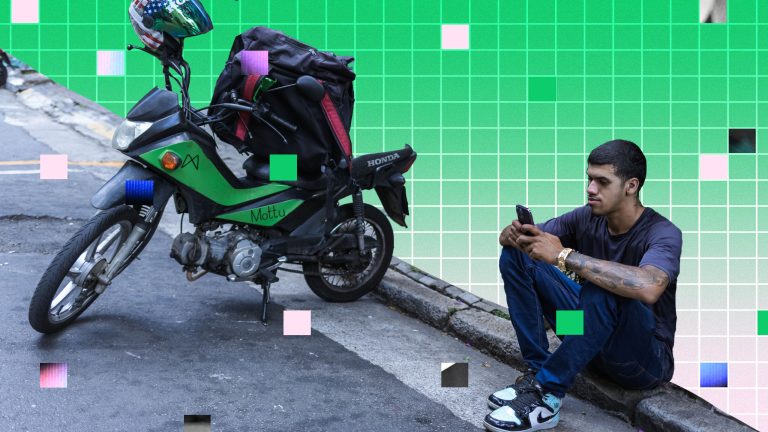Ukrainian democracy is known for its theatrics. Since the collapse of the Soviet Union, Ukraine’s parliament has become notorious for stunts, brawls, and the practice of “piano voting” — when a member of parliament goes from one seat to another, rapidly casting votes for absent colleagues.
Earlier this year, Ukrainian President Volodymyr Zelensky — a former comedian who played the president on Ukrainian television before becoming the real Ukrainian president — decided he had had enough of the show. Though his party had the majority of seats in parliament, many members weren’t voting with the bloc, causing the party to lose confirmations and votes on bills.
Zelensky’s solution was to make members of his faction download an app onto their smartphones, which recorded their attendance and how often they voted with the party. The app then generated an Uber-like rating for each legislator. Ukrainian media called the app “big brother in a smartphone,” but by spring, discipline had returned to the party.
The system — which was just one factor in restoring discipline, alongside the president’s decision to stand up to the oligarchs who had been trying to split up his voting blocs — shows how Zelensky and his team see solutions to Ukraine’s bureaucratic problems: in all-encompassing apps.
When Zelensky ran for the presidency in 2019, he promised to change the tone of Ukrainian politics, which continued to be mired incorruption and backroom deals. One of his key focuses was on using technology to improve both the reality of day-to-day life and Ukraine’s image abroad under the motto of a “state in a smartphone.” Within five years, all the services of the country’s paper-loving bureaucracy were to be transferred online. The flagship of this initiative was an app, Diia, which means both “the state and me” in Ukrainian, and what the Ukrainian state has not historically been known for: “action.”
Launched in February 2020, the system encompasses a spectrum of state functions, from birth certificates and passports to business registration. According to the Ukranian government’s statistics, more than 10 million people — nearly a quarter of the population — use Diia.
“Zelensky is a person of the new generation and considers Diia one of his top priorities,” Vladimir Fesenko, head of the Penta Center of Applied Political Studies in Kyiv told Rest of World. “Ukraine was behind many countries and now it is trying to catch up.”
The person tasked with bringing Diia to life was Mykhailo Fedorov. Before entering government, Fedorov ran his own digital marketing company, which focused on social media ads. He also oversaw the online front of Zelensky’s unorthodox presidential campaign, which featured no public speeches, rallies, or press conferences. Instead, Zelensky tried to connect with voters through social media on Instagram, YouTube, and Facebook.
Fedorov was the main architect of the campaign, branding Zelensky “Ze” and recruiting an army of social media experts and volunteers, who pushed a message of change and energy around the young candidate, a break from the staid mudslinging of previous political campaigns inside Ukraine. When the presidential election was over, Fedorov did it again for the parliamentary elections, which Zelensky’s party won by a landslide.
At just 28, Fedorov was made minister in the newly created Ministry of Digital Transformation. Since then, he has tried to run his ministry more like a startup than a stuffy government agency, pulling in young professionals from Ukraine’s tech community, and committing himself to cutting through “bureaucratic bullshit.”
In the territorial world of Ukrainian ministerial politics, that wasn’t always easy. “In the early days, we would go to the other ministries we needed to work with on projects and they would say, ‘That’s great guys, but do it without us’,” Mstyslav Banik, director of e-Services in the Ministry of Digital Transformation told Rest of World. The deadlock was broken when Fedorov was promoted to vice prime minister, with authority over other ministries, he said.
In May, the Ministry of Digital Transformation held Diia Summit 2.0, where the department launched digital services that included being able to register as an individual entrepreneur, register your place of residence, and file and pay your taxes online. The event was far from a typical government press conference, taking place in a hushed room backed by a video from a celebrity borscht chef in TikTok-style montages.
“What used to take weeks or months now only takes ten or twenty minutes, depending on how good you are with a smartphone,” Zelensky told the room. “We’ve already enacted a digital revolution.”
Ukrainians can already use Diia to apply for state payments to support newborn children, establish their tax status, and open a business. Officials say it has reduced the low-level corruption that used to be associated with applying for these services in person. In March, Ukraine became the first country in the world to give digital passports the same status as physical documents.
That success has only been possible because of the prevalence of smartphone use in Ukraine. Though the country remains one of the poorest countries in Europe, with an average monthly wage of around $500 a month, smartphone use is widespread. To increase Diia’s availability, Zelensky and Fedorov have been pushing to expand Ukraine’s 4G network. At the Diia 2.0 Summit, Zelensky announced that over 2 million Ukrainians had been connected to the 4G network in the previous six months.
“A computer has no friends or godfathers, and doesn’t take bribes. Not even Bitcoin.”
Ukraine’s strategy of investing in technological infrastructure to reinvent its international image is partly inspired by Estonia, which began putting internet connections in schools soon after its independence in the 1990s. Since then, the country has been at the forefront of civic innovation in Europe.
“They study the Estonian case in Ukraine,” said Fesenko, who sees Estonia as a successful example of a country that has broken free from the image of backwardness Ukraine still struggles with. “But there is a different scale. Estonia is a small, compact country. Ukraine is far larger and our roads are worse than they were in Estonia in the ’90s.”
Not everything Zelensky’s team has tried has succeeded. Ukraine’s Covid-19 monitoring app, designed by the Ministry of Digital Transformation, was an initial failure. The app was supposed to ensure that travelers returning to Ukraine self-quarantined in their homes for two weeks. Users had to verify that they were at home by sending a selfie in response to notifications. But the notifications often failed to make a sound or vibrate, users missed them, and were reported automatically to the police for violating the terms of their quarantine. At other times, the app immediately told newly-arrived passengers who were supposed to quarantine that their quarantine was over. The app was later updated to fix these issues.
Some of this could be down to a startup-like approach to rolling out products. At the core of Fedorov’s philosophy is to launch things quickly, and then improve them, rather than waiting for conditions to be perfect. Recalling the launch of Diia, Fedorov recently told Ukrainian journalist Alesia Batsman in an interview on her YouTube channel, “The infrastructure wasn’t ready for a project of this scale. We had two options: either build the infrastructure and launch Diia in two to three years, or do both at the same time. We chose to do both at the same time.”
But some critics worry about the approach of running vital government services in beta when the country is in the seventh year of a war with Russia, and when Russia routinely targets the country with cyberattacks.
“What I am afraid of is cybersecurity,” said Andrii Osadchuk, an opposition member of parliament and the former chief regulatory officer of Ukraine’s largest mobile provider, Kyivstar. “The majority of telecom networks have indirect influence from Russians.” Kyivstar is Amsterdam-based, but Russian-owned. The second-largest mobile provider in the country, Vodafone Ukraine, was Russian-owned until 2019.
The Ministry of Digital transformation said that any data risk is mitigated by the fact that Diia does not store data, but rather only displays encrypted information from other government registries. Diia has also passed two penetration tests, organized with the assistance of the Estonian e-Governance Academy and the American aid agency USAID, which simulated a cyberattack on the system. The U.S. has already spent $40 million on cybersecurity initiatives in Ukraine since 2014, according to the U.S. embassy in Kyiv, and is in the middle of another $38 million cybersecurity program. In December 2020, USAID funded a competition to test the security of Diia with a $34,500 prize for discovering critical vulnerabilities, the embassy said. None were found.
Diia came under fire last May when it was discovered that a bot on the Telegram was selling approximately 900GB of Ukrainian citizens’ data, including passport numbers, personal tax numbers, residence information, and driver’s licenses. Some officials blamed Diia for the leak. Ukrainian police claimed that Diia was not the source of the leaks.
Meanwhile, efforts to digitize Ukraine’s government continue to move ahead rapidly. Zelensky recently announced the government will go paperless in August, fulfilling one of his campaign promises. The latest update for Diia includes an option that will allow Ukrainians to vote in online referenda using the app.
Fedorov has said that all government services will be digitized by 2024, the year of the next Ukrainian presidential election. So far, he has declined to say whether that election would take place online.
Zelensky claims that alongside introducing efficiencies, digitization may also have the added benefit of addressing the country’s history of corruption. At the Diia 2.0 Summit, Zelensky explained: “A computer has no friends or godfathers, and doesn’t take bribes,” Zelensky said at the Diia 2.0 Summit. “Not even Bitcoin.”



